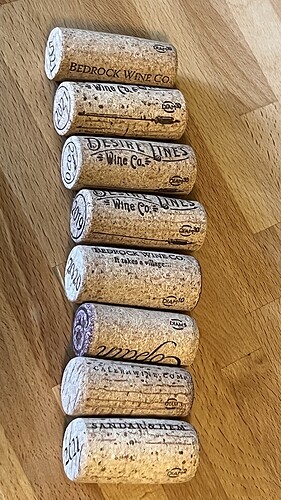Of course. I recently had one from Marcus who graciously offered a return and freely admitted he’s had plenty of others.
I’m not sure how we’ve made it this far without someone making a message in a bottle joke…
So are you sending an S.O.S. to the board?
Curious whether @Marcus_Goodfellow thought it was ‘corked’ or something else…
Cheers
I had a corked wine under DIAM once. Walter Scott kindly replaced the bottle. I posted about it on this board in fact;
Ha! And now I realize you (Larry) had lots of messages in that thread.
I have come across a TCA tainted DIAM, was surprised to say the least. Though that was the one and only…
So far we are up to four reports of corked bottles under DIAM over what time period? I had four corked bottles with regular corks last month!
Mine was perhaps 2 years ago, and Vince I’ve experienced about a dozen others without TCA. And during that tasting where I experienced the TCA, there were 5 others that did not have any TCA.
Cheers
I’ll take my chances with the Diam TCA risk, it’s much lower. I think oxidation risk is also much lower than with natural cork. Nothing is perfect, though.
-Al
We import thousands of cases a year of wine closed with Diam, and I’ve never had a corked bottle with it, other than the small number of bottlings that suffered from environmental TCA, which of course had nothing to do with the cork. I love the closure.
Unless I missed it, my question has not really been answered. Maybe lack of coherence in expressing it, or maybe just a WB thread walk.
I’m interested in how and why a winemaker who uses DIAM closures makes his final selection for a particular number from the various choices of numbers eg 3, 5, 10, etc AND ESPECIALLY if the choice is (intentionally or not) also sending a message on whether the winemaker views the wine as a short, mid, or long term drinker.
Any winemakers here on WB who use DIAM want to chip on?
The answer to your question is already in your question.
If she didn’t want to kiss you, in what way was she a girlfriend?
There’s been discussions about this with winemakers in other threads, like the main DIAM thread. They make the choice for various reasons, cost and ideal wine development two of the highest. Marcus bottled a cask under DIAM 30 as a trial many years ago and found that the wine develops at a glacial pace, too slow for his taste because it allows almost no air transfer. So he continues to use DIAM 10 for his bottlings because he finds the development to be comparable to cork.
I also find the highest end GCs like Monty from some producers under DIAM 10, not 30. I don’t see 30 used a lot. Then again there’s a few producers that use DIAM 30 for everything even village stuff. I think at that point it’s more a status statement as these wines are not cheap and DIAM 30 is quite expensive per cork.
I typically find DIAM 5 used for lots of what I would call daily drinker village stuff.
DIAM 3 to me just feels like a cost savings because it’s cheaper and I typically only see it used for really low end wines. But maybe in the US it’s different.
Quick survey from my recent pile of closures: Bedrock and Desire Lines Riesling has been under DIAM30 for at least three years. Bedrock OVZ, DIAM10. Copain Les Voisins Pinot, DIAM5 since at least 2016. Calera Central Coast Pinot, DIAM3. Sandar & Hem Grenache Rose, DIAM2.
I’d go with “Dee-um”, since it’s a French company.
Don’t think “AM” becomes “UM” pronouncing it the French way (at least what I can remember from my admittedly poor school French). “Dee-am” sounds more like it to me.
I think the original premise of this thread points to a flaw in tasting that we should all try to avoid (but few of us do - including me). It is fabulous to learn more about each and every detail of how wine is made, but we should forget those details when tasting the wine. The wine either stands on its own or it does not. How the grapes were grown, whether (and how much new oak was used), how the wine was closed (cork, screwcap, DIAM, etc.), etc., etc., etc., [Even the terroir of the vineyards where the grapes are grown.] have an influence in what the wine tastes like, but if we come into wines with preconceptions of how good the wine will be because of inputs, we lose the opportunity to learn.
I have had really good wines where a lot of new oak was used and overoaked wines where less oak was used. I have had great wines from grand cru vineyards and wines that were not from grand cru vineyards.
I find the OP’s post to be a lesson to all of us to try not to come to a bottle of wine with too many preconceptions.
And indeed the people who make the darned things say “Dee-Am.”
That should end the debate (but it won’t). ![]()
